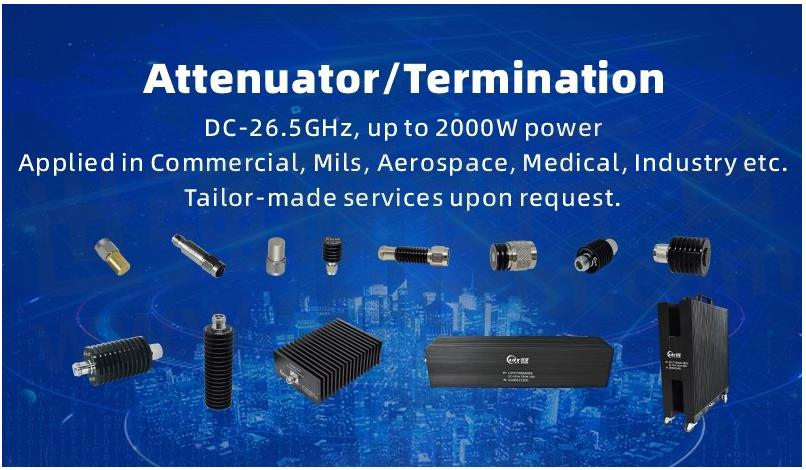A Quick Introduction to Coaxial Attenuators

A coaxial attenuator is an energy-degrading RF/microwave component that contains resistive materials inside. In addition to the commonly used resistive fixed attenuators, there are also electronically controlled fast-adjustment attenuators. Attenuators are widely used in a variety of applications where power level adjustment is required.
The basic materials that make up a coaxial attenuator are resistive materials. Typical resistance is a basic form of coaxial attenuator, and the resulting network of resistance attenuators is a lumped parameter attenuator. Through a certain process, the resistive material is placed into the RF/microwave circuit structure in different bands to form an attenuator of the corresponding frequency. If it is a high-power attenuator, the size must be increased, and the key is the heat dissipation design.
With the development of modern electronic technology, fast-adjusting attenuators are used on many occasions. This attenuator is usually implemented in two ways, one is a semiconductor low-power fast modulation attenuator, such as a PIN tube attenuator or FET monolithic integrated attenuator; The second is the resistance attenuation network controlled by the switch, which can be an electronic switch or an RF relay.
The technical specifications of the coaxial attenuator include the operating frequency band, attenuation, power capacity, return loss, etc.
Working Frequency Band: The working frequency band of the attenuator refers to the use of the attenuator in a given frequency range, and the attenuator can reach the index value. Since the RF/microwave structure is related to frequency, the components of different frequency bands have different structures and cannot be universal. Modern Coaxial Attenuators use a wide operating frequency band, and attention should be paid to attention during design or installation.
Attenuation: Regardless of the mechanism and specific structure of power attenuation, the attenuator can always be described by a two-port network.
The power at the signal input is P1, the power at the output is P2, and the attenuator power attenuation is A(dB). If P1 and P2 are expressed in decibel milliwatts (dBm), the relationship between the power across the two is P2(dBm) = P1(dBm) – A(dB).
It can be seen that the amount of attenuation describes how much the power decreases after it passes through the attenuator. The magnitude of the attenuation is determined by the material and structure that make up the attenuator. The attenuation amount is measured in decibels, which is convenient for the calculation of the whole machine index.
Power Capacity: The attenuator is an energy consumption component, the energy becomes heat after power is consumed. As you can imagine, after the material structure is determined, the power capacity of the attenuator is determined. If the attenuator is subjected to higher power than this limit value, the attenuator will be burned. When designing and using, the power capacity must be clarified.
Return Loss: Return loss is the standing wave ratio of the attenuator, and the input-output standing wave ratio at both ends of the attenuator should be as small as possible. The ideal attenuator has to be a power-consuming component that doesn’t affect the circuit at both ends, that is, match the circuit across the circuit. It is very important to consider this factor when designing attenuators.
Main Functions:
Control the power level: control the output power of the local oscillator in the microwave superheterodyne receiver to obtain the best noise figure and frequency conversion loss to achieve the best receiving effect. In microwave receivers, automatic gain control is implemented to improve dynamic range.
Decoupling component: as a decoupling component between the oscillator and the load.
Relative standard: as a relative standard for comparing power levels.
Hop attenuator used in radar anti-jamming: it is a variable attenuator with sudden change in attenuation and energy, which usually does not introduce attenuation, and suddenly increases attenuation when encountering external interference.
From the point of view of microwave networks, a coaxial attenuator is a two-port consuming microwave network. It belongs to the pass-through microwave element.

- +1 Like
- Add to Favorites
Recommend
- Kinghelm RF Coaxial Connector KH-SMA-K514-13N for Improving Wireless Communication Quality
- What is Waveguide to Coaxial Adapter?
- What Coaxial Cables Should We Use on Military Vehicles?
- Smiths Interconnect Has Extended Its Broad Range of Coaxial Coupler Components in UHF to Ku-Band
- Nextron‘s 1.0 mm 110GHz SMA Coaxial Connector
- Hosiden Publishes Double-shielded Structure Coaxial Receptacle CMS1953 Intended for Use in Transmission Applications
- Times Microwave Systems Opens The Era of High-performance Coaxial Cables and Launches LMR Series Products
- Fixed Attenuators for Space and Defense Applications: Ensuring Reliability and Durability
This document is provided by Sekorm Platform for VIP exclusive service. The copyright is owned by Sekorm. Without authorization, any medias, websites or individual are not allowed to reprint. When authorizing the reprint, the link of www.sekorm.com must be indicated.





























































































































































































































































































































































































































































































































































































































































































































































































































































































